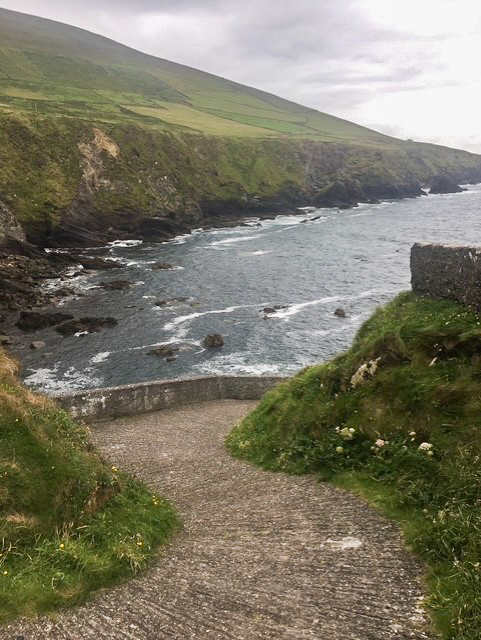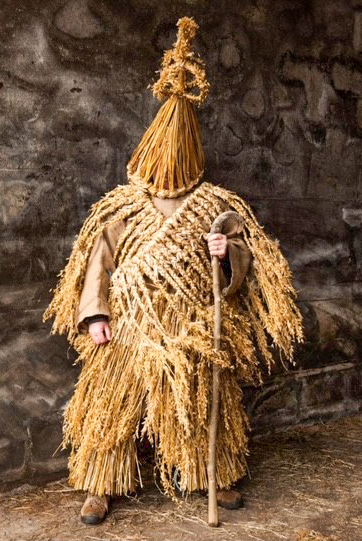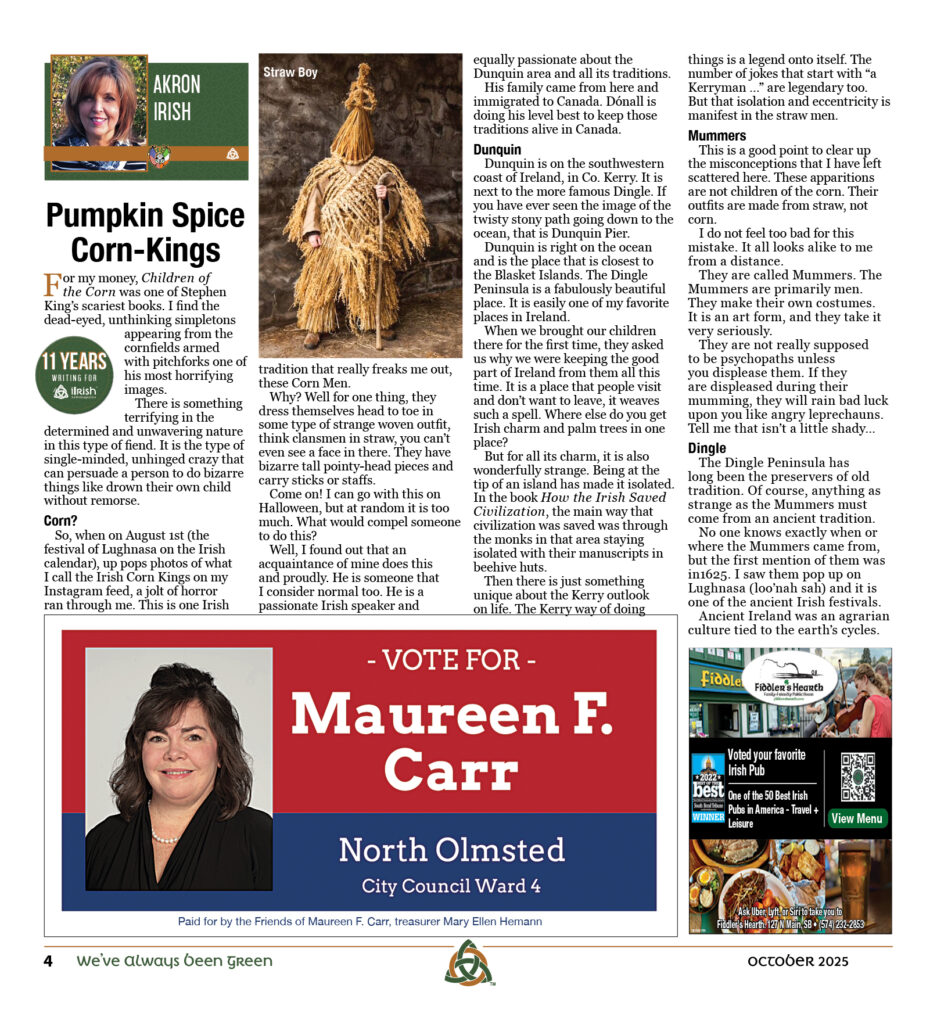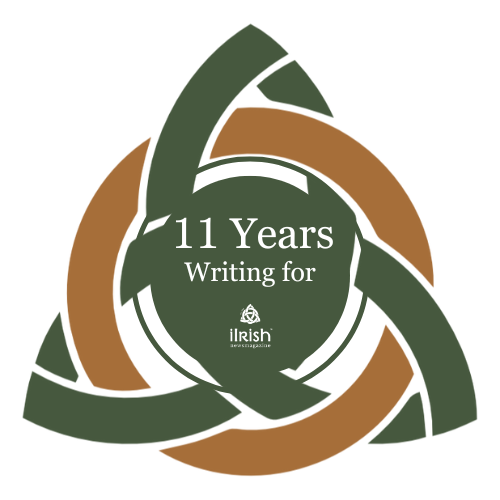
Pumpkin Spice Corn-Kings
For my money, Children of the Corn was one of Stephen King’s scariest books. I find the dead-eyed, unthinking simpletons appearing from the cornfields armed with pitchforks one of his most horrifying images.
There is something terrifying in the determined and unwavering nature in this type of fiend. It is the type of single-minded, unhinged crazy that can persuade a person to do bizarre things like drown their own child without remorse.
Corn?
So, when on August 1st (the festival of Lughnasa on the Irish calendar), up pops photos of what I call the Irish Corn Kings on my Instagram feed, a jolt of horror ran through me. This is one Irish tradition that really freaks me out, these Corn Men.
Why? Well for one thing, they dress themselves head to toe in some type of strange woven outfit, think clansmen in straw, you can’t even see a face in there. They have bizarre tall pointy-head pieces and carry sticks or staffs.
Come on! I can go with this on Halloween, but at random it is too much. What would compel someone to do this?
Well, I found out that an acquaintance of mine does this and proudly. He is someone that I consider normal too. He is a passionate Irish speaker and equally passionate about the Dunquin area and all its traditions.
His family came from here and immigrated to Canada. Dónall is doing his level best to keep those traditions alive in Canada.
Dunnquin
Dunquin is on the southwestern coast of Ireland, in Co. Kerry. It is next to the more famous Dingle. If you have ever seen the image of the twisty stony path going down to the ocean, that is Dunquin Pier.
Dunquin is right on the ocean and is the place that is closest to the Blasket Islands. The Dingle Peninsula is a fabulously beautiful place. It is easily one of my favorite places in Ireland.
When we brought our children there for the first time, they asked us why we were keeping the good part of Ireland from them all this time. It is a place that people visit and don’t want to leave, it weaves such a spell. Where else do you get Irish charm and palm trees in one place?
But for all its charm, it is also wonderfully strange. Being at the tip of an island has made it isolated. In the book How the Irish Saved Civilization, the main way that civilization was saved was through the monks in that area staying isolated with their manuscripts in beehive huts. Then there is just something unique about the Kerry outlook on life. The Kerry way of doing things is a legend onto itself. The number of jokes that start with “a Kerryman …” are legendary too. But that isolation and eccentricity is manifest in the straw men.

Mummers

This is a good point to clear up the misconceptions that I have left scattered here. These apparitions are not children of the corn. Their outfits are made from straw, not corn.
I do not feel too bad for this mistake. It all looks alike to me from a distance.
They are called Mummers. The Mummers are primarily men.They are called Mummers. The Mummers are primarily men. They make their own costumes. It is an art form, and they take it very seriously.
They are not really supposed to be psychopaths unless you displease them. If they are displeased during their mumming, they will rain bad luck upon you like angry leprechauns. Tell me that isn’t a little shady…
Dingle
The Dingle Peninsula has long been the preservers of old tradition. Of course, anything as strange as the Mummers must come from an ancient tradition.
No one knows exactly when or where the Mummers came from, but the first mention of them was in1625. I saw them pop up on Lughnasa (loo’nah sah) and it is one of the ancient Irish festivals.
Ancient Ireland was an agrarian culture tied to the earth’s cycles. Lughnasa marked the beginning of the harvest season. Straw makes sense for the harvest festival. But that is not the Mummer’s big day out.
Lughnasa
The appearance in August is unique to Kerry. The first weekend in August is a bank holiday, a three-day weekend. It is also the weekend that all the rural towns put on their fairs, still marking the harvest.
These fairs are a lot like our county fairs, minus the fried Oreos. You would see a lot of animals, homemade jams, cakes, and more small-town flair.
September, called Mean Fomhar in Irish are halfway through the harvest. By our calendar, Fall does not start until mid September. By Irish standards, it’s OK to start the pumpkin spice in August.
Wren Day
Christmas is not an ancient festival in the old calendar. It is close to the winter solstice, the shortest day of the year.
The day after Christmas, December 26, St. Stephen’s Day, is a special day in Ireland. It is also called Wren Day. That is the day that the Mummers come out in force.
Wren Day is celebrated all over the country, especially in the rural areas. In most areas, young people go door to door in costume, playing music or singing and collecting money for charity.
In Kerry and in Northern Ireland, the Mummers go out. They used to have an elaborate hunt for a wren. But now they do the same singing and playing music for charity. The town has a big ceili for the end of Wren Day and it is a celebration in Dunquin.
A good Wren Day means prosperity in the new year. It is another occasion to get your straw outfit out in Kerry.
The last of the festival days is Beltaine, on May 1st. That day is celebrated in many countries as a workers’ holiday. But it is a day to mark the beginning of planting and mild weather.
It is the beginning of spring and blooming and the earth waking up after the winter. Darned if those straw outfits don’t come out yet again in Kerry on this day.
Ireland is not a country that was setup to honor the turn of seasons by marketing cues. The first fallen leaf does not signal pumpkin spice everything there. Their “pagan” holidays are not necessarily pagan at all. They have a lot to do with farmers preparing for the coming season. And then there are some people who enjoy wearing straw.





